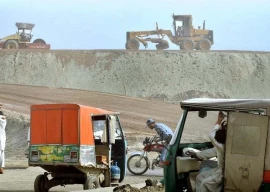
“Initial excavations around Ganderviwala Dher marked the site at 81 hectares but recent research suggests its size is 32 hectares,” said Farzand Masih, a researcher from the Forman Christian College.
He was speaking at a dialogue held at the Lahore Museum on Sunday as part of a two-day discussion on the Harrapan civilisation. Researchers and experts on the topic discussed their findings and shared their understanding of the civilization at the dialogue.
Mustansar Hussain Tarar talked about his novel Bahao set 4,000 years ago. He said he had done extensive research on habits, especially expressions of love and affection, at the time.

Farzand Masih, a professor from Forman Christian College, spoke on excavations from Cholistan. He said there were nearly 450 sites of historical importance in the desert.
Masih talked about the Ganderviwala Dher site, 25 kilometres southwest of Derawar Fort. He said the first excavations at the site had been undertaken during his time at the Punjab University. He said the team had left a reference point for future excavations. Masih said the site was the third largest centre of the Harrapan civilization found to date.
He said earlier research by Dr MR Mughal had showed that the site was spread over 81 hectares but recent research had reported 32 hectares.
“It is important to ask how the site disappeared,” he said.
Masih also talked about objects recovered from the site.
He spoke about a clay tablet with the yogi on it. He said seven such tablets had been found from various Harrapan sites.
Masih also discussed Damana Vihar, a Buddhist site in Cholistan, 20 kilometres from Bahawalpur. He said the structure found there was unique.
Speaking of vandalism at ancient sites, he said part of Damana Vihar site was being used as a graveyard. He said an unmetalled road had been built on the mound of Ganderviwala to facilitate hunters from the UAE. He said development projects in the area were also a threat to these sites.
Nafees Ahmad about ornamental female figurines found from Mehargarh. He had divided the figurines in to eight periods under the Neolithic era.
He said Mehargarh was important because it was among the early settlements which started cultivation and domestication of animals.
He said the site was near Quetta and was discovered in 1974 by a French team.
He said initially figurines had lacked facial features, but in the second period, a clay strip, symbolising a necklace appeared. He said during the third period they had not found any human figures. He said bovine figures were found extensively. “They were probably worshipped during the time,” he said.
He said the type of jewellery and hairstyles depicted on the figurines were similar to styles today.
“The hair was painted black which is still the predominant hair colour in the region,” he said.
Ahmad said some figures had red colour painted in the hair parting, which was similar to the sindur used by Hindu women.
Published in The Express Tribune, November 23rd, 2015.






























COMMENTS
Comments are moderated and generally will be posted if they are on-topic and not abusive.
For more information, please see our Comments FAQ